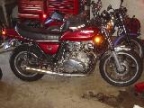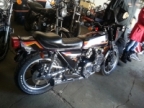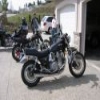Reading This May Solve Your Leaking Carburetor Float Needle Valve And Seat Problems
- greaseyfingers
-
Topic Author
- Offline
- User
-

Registered
- Posts: 4
- Thanks: 0
Reading This May Solve Your Leaking Carburetor Float Needle Valve And Seat Problems
12 Sep 2008 00:07 - 12 Sep 2008 00:16A Remedy For Stopping A Leaking Carburetor Float Needle Valve And Seat, on my 76 Kawasaki KZ 900 and 79 Kawasaki KZ 1000 ST.
Do you know what causes gasoline to drip out of the over flow tube of your carburetor?
The short answer is that a tiny piece of dirt is most likely stuck in the needle and seat of the float valve, preventing the valve from fully seating. Or else your float valve may need to re re-adjusted, or replaced (due to wear on the needle valve and seat), to lower your fuel level in the carburetor float bowl.
However, I'd like to give you a bit more background on this important question. I used to think that the float valve in the carburetor operated like the float valve in the tank of a toilet: i.e., when water in the tank got low (as in after flushing), the valve would open until the tank filled and then close again. However, it is important to realize that (unlike our toilet tanks) the needle in the carburetor float valve is always closed. What varies is the pressure that the carburetor float exerts on the needle: relatively high as the fuel level increases, and relatively low as the fuel level decreases.
This means that the fuel pressure (on the inlet side of the valve) is in constant equilibrium with the pressure exerted by the needle (on the carburetor side of the valve), so that a very constant level is maintained in the float chamber.
Understanding that the needle of the float valve is always being pressed against the seat is important in understanding why any tiny bit of dirt can cause so much trouble. Once a piece of dirt gets caught between the needle and the seat, it will be held there and interfere with the needle valve's ability to control the fuel level, until such time as fuel is drained from the carburetor and the piece of dirt is flushed away. This is the reason for the flushing procedure of the fuel system, by removing the drain plug from the bottom of the float bowl and let enough fuel run out, which will usually rinse off the the debris that is on the needle valve and seat, as fuel is running out of the float bowl drain plug hole.
To help prevent this problem from happening, again. It's a good idea to put a good inline fuel filter between your gas tank and carburetors that keeps your fuel system very clean going to your carburetor's float valve and seat, which also prevents having other problems in your carburetor, too.
In addition to dirt causing the valves to stick open, I have seen a few cases where the brass seat of the float valve needs to be polished (smoothed out) by pressing and rotating a short pointed hardwood dowel into its small orifice. Dowels of 3/16†diameter work well. I have even had to clean up brand new seats in this fashion before they would stop leaking.
Last edit: 12 Sep 2008 00:16 by greaseyfingers.
Please Log in or Create an account to join the conversation.
- KZQ
-
- Offline
- Administrator
-

Registered
- Walking Behind the Corn May Not Be All That!
- Posts: 4851
- Thanks: 1653
Re: Reading This May Solve Your Leaking Carburetor Float Needle Valve And Seat Problems
12 Sep 2008 18:51
Hey GF,
I've got to say that you opened my eyes! I never realized that you are absolutely correct that these valves never fully open and flush away the debris.
You got it going on!
KZCSI
I've got to say that you opened my eyes! I never realized that you are absolutely correct that these valves never fully open and flush away the debris.
You got it going on!
KZCSI
www.KZ1300.com
Riders:
1968 BSA 441 Shooting Star, 1970 BSA 650 Lightning, 1974 W3, 1976 KZ900, 1979 KZ750 Twin, 1979 KZ750 Twin Trike, 1981 KZ1300, 1982 KZ1100 Spectre, 2000 Valkyrie, 2009 Yamaha Roadliner S. 1983 GL 1100
Projects:
1985 ZN1300
Riders:
1968 BSA 441 Shooting Star, 1970 BSA 650 Lightning, 1974 W3, 1976 KZ900, 1979 KZ750 Twin, 1979 KZ750 Twin Trike, 1981 KZ1300, 1982 KZ1100 Spectre, 2000 Valkyrie, 2009 Yamaha Roadliner S. 1983 GL 1100
Projects:
1985 ZN1300
Please Log in or Create an account to join the conversation.
- greaseyfingers
-
Topic Author
- Offline
- User
-

Registered
- Posts: 4
- Thanks: 0
Re: Reading This May Solve Your Leaking Carburetor Float Needle Valve And Seat Problems
13 Sep 2008 08:18 - 14 Sep 2008 07:37
KZCSI wrote:
turn the gas tank petcock valve off, if you have one, while the motorcycle is running, until the engine runs out of gas..
then, turn the gas tank petcock valve open, again.. the gasoline will gush into the carburetors.. which will flush off the carburetor float needle valves and seats, with a flow of fresh gas, as the carburetor float bowls are refilling to reach their fuel level, again..
this method is meant, only, as a temporary on the road remedy procedure for helping you to try and stop your needle valve from leaking, to try and get you out of your predicament, if you don't have access to a screw driver, at the time, for removing your carburetor float bowl drain screws, which would be the preferred method, if you have the opportunity to do so..
otherwise, try this procedure as mentioned, as you wouldn't have anything to loose, if your carburetor float needle valve is leaking bad, while your on the road.. as they say, nothing ventured, nothing gained.. then later as soon, as you have access to using a screw driver.. remove your carburetor float bowls drain screws and drain your fuel system thoroughly..
some good advice to consider would be to install a good inline fuel filter, instead of just relying on the gas tank's fuel filtering system, which on some motorcycles is only a filtering mesh screen on the fuel tank petcock..
it would be well worth your time and effort to install a good inline fuel filter between the gas tank petcock and the carburetor's fuel rail.. which will eliminate any minute microscopic particles from getting down to the carburetor's needle valves and seats.. and these minute particles may, also, accumulate in your carburetor's pilot jets and main jets causing more engine performance problems.. especially as small as the orifice is in the pilot jet.. they clog really easy from inadequately filtered fuel..
anyone who has had carburetor problems, before, knows how frustrating it can be, if you've taken the time to have cleaned all the internals of your carburetors really good.. only to discover, often times, your motorcycle will run decent, again, for a short time, before your carburetor problems start, all over, again, from a inconspicous, invisible dirty fuel delivery system..
because these particles are so very small, which will cause carburetor needle valves and seats to leak.. many people don't even realize that, most times, you can't even see them.. and if you've trusted and relied on your motorcyle's fuel filtering system, in the gas tank, to provide clean fuel to the carburetor's, which often times it hasn't.. especially on older motorycles with rusty gas tanks on the inside, that a lot of people aren't aware of..
to keep all of your carburetor's internal working components super clean.. install a good inline fuel filter, every so often, as needed, and they will always stay clean..
which will eliminate having any kind of carburetor problems, from a dirty fuel delivery system, that can be avoided by this kind of preventative maintenace, as described, by installing a good inline fuel filter..
as they, a ounce of prevention is worth a pound of cure..
if you've taken the time to have read this information.. and have found it to be helpful..
feel free to share your thoughts, opinions, and comments, in regard to this discussion..
a good way to quickly flush off the carburetor float needle valves and seats, if one starts leaking, unexpectedly, without having to remove the carburetor float bowl drain screws, if it's on a motorcycle that has a fuel petcock that can be manually turned to the off position..Hey GF,
I've got to say that you opened my eyes! I never realized that you are absolutely correct that these valves never fully open and flush away the debris.
You got it going on!
KZCSI
turn the gas tank petcock valve off, if you have one, while the motorcycle is running, until the engine runs out of gas..
then, turn the gas tank petcock valve open, again.. the gasoline will gush into the carburetors.. which will flush off the carburetor float needle valves and seats, with a flow of fresh gas, as the carburetor float bowls are refilling to reach their fuel level, again..
this method is meant, only, as a temporary on the road remedy procedure for helping you to try and stop your needle valve from leaking, to try and get you out of your predicament, if you don't have access to a screw driver, at the time, for removing your carburetor float bowl drain screws, which would be the preferred method, if you have the opportunity to do so..
otherwise, try this procedure as mentioned, as you wouldn't have anything to loose, if your carburetor float needle valve is leaking bad, while your on the road.. as they say, nothing ventured, nothing gained.. then later as soon, as you have access to using a screw driver.. remove your carburetor float bowls drain screws and drain your fuel system thoroughly..
some good advice to consider would be to install a good inline fuel filter, instead of just relying on the gas tank's fuel filtering system, which on some motorcycles is only a filtering mesh screen on the fuel tank petcock..
it would be well worth your time and effort to install a good inline fuel filter between the gas tank petcock and the carburetor's fuel rail.. which will eliminate any minute microscopic particles from getting down to the carburetor's needle valves and seats.. and these minute particles may, also, accumulate in your carburetor's pilot jets and main jets causing more engine performance problems.. especially as small as the orifice is in the pilot jet.. they clog really easy from inadequately filtered fuel..
anyone who has had carburetor problems, before, knows how frustrating it can be, if you've taken the time to have cleaned all the internals of your carburetors really good.. only to discover, often times, your motorcycle will run decent, again, for a short time, before your carburetor problems start, all over, again, from a inconspicous, invisible dirty fuel delivery system..
because these particles are so very small, which will cause carburetor needle valves and seats to leak.. many people don't even realize that, most times, you can't even see them.. and if you've trusted and relied on your motorcyle's fuel filtering system, in the gas tank, to provide clean fuel to the carburetor's, which often times it hasn't.. especially on older motorycles with rusty gas tanks on the inside, that a lot of people aren't aware of..
to keep all of your carburetor's internal working components super clean.. install a good inline fuel filter, every so often, as needed, and they will always stay clean..
which will eliminate having any kind of carburetor problems, from a dirty fuel delivery system, that can be avoided by this kind of preventative maintenace, as described, by installing a good inline fuel filter..
as they, a ounce of prevention is worth a pound of cure..
if you've taken the time to have read this information.. and have found it to be helpful..
feel free to share your thoughts, opinions, and comments, in regard to this discussion..
Last edit: 14 Sep 2008 07:37 by greaseyfingers.
Please Log in or Create an account to join the conversation.
- RonKZ650
-

- Offline
- User
-

Registered
- Posts: 3714
- Thanks: 250
Re: Reading This May Solve Your Leaking Carburetor Float Needle Valve And Seat Problems
13 Sep 2008 10:11
I guess I don't fully understand. The way the needle/seat works is of course the seat is rigedly mounted to the body of the carbs, the needle is pointing upwards into the seat. Gravity pulls the needle down till it is stopped by the tang on the float. The float is down, the needle is down allowing gas to flow. Float is up the needle is pushed up into the seat shutting off gas. There is a spring load on the needle that makes for a little give in the setup. So really the floats do work just like a toilet, the valve is open allowing fluid to flow or closed stopping flow. Of course the needle doesn't move 1/2" down or anything that extreme, but the needle will drop out of the seat a good 1/8" when the bowl is completely empty.
321,000 miles on KZ's that I can remember. Not going to see any more.
Please Log in or Create an account to join the conversation.
- Patton
-

- Offline
- KZr Legend
-

Registered
- Posts: 18568
- Thanks: 2104
Re: Reading This May Solve Your Leaking Carburetor Float Needle Valve And Seat Problems
13 Sep 2008 10:37
While I concur with Ron650, am thinking what's intended for reference is the miniscule float needle movement during normal operation where the float is dependent on the relatively constant fuel level in the float bowls, and not the needle location at its lowest possible position when the float bowl is empty.
I would suggest the alternative flush method alluded to where carbs have a float bowl drain screw -- drain float bowl by completely removing drain screw and leave drain screw completely out of the bowl. Then allow fuel to flow through -- and keep flowing through -- until crud or grit or whatever is believed removed from the needle/seat orifice and flushed away outside the bowl.
And of course >
Z1E's selection of inline fuel filters
Good Luck!
I would suggest the alternative flush method alluded to where carbs have a float bowl drain screw -- drain float bowl by completely removing drain screw and leave drain screw completely out of the bowl. Then allow fuel to flow through -- and keep flowing through -- until crud or grit or whatever is believed removed from the needle/seat orifice and flushed away outside the bowl.
And of course >
Z1E's selection of inline fuel filters
Good Luck!
1973 Z1
KZ900 LTD
KZ900 LTD
Please Log in or Create an account to join the conversation.
- steell
-

- Offline
- User
-

Registered
- Posts: 6849
- Thanks: 208
Re: Reading This May Solve Your Leaking Carburetor Float Needle Valve And Seat Problems
13 Sep 2008 10:38a good way to flush off the carburetor float needle valves and seats, without removing the carburetor float bowl drain screws, is to temporarily turn the gas tank petcock valve off, while the motorcycle is running, until the engine begins to miss, as it's starting to run out of gas..
The 750 twins have on/off valves, and I think the 400 does also, but what other KZ models have on/off petcocks? Seems like most of the ones I see have On, Prime, and Reserve, but no Off position.
greaseyfingers statement is sorta true, under specific operating conditions, but false under other conditions. There are certain combo's of motors and carbs that will actually suck the float bowls dry under WOT, and others that lower the float level till the hole is totally unblocked under wide open throttle.
WG expounded on the subject one time.
KD9JUR
Please Log in or Create an account to join the conversation.
- wiredgeorge
-

- Offline
- User
-

Registered
- Posts: 5309
- Thanks: 45
Re: Reading This May Solve Your Leaking Carburetor Float Needle Valve And Seat Problems
13 Sep 2008 11:31
Hmmm I don't remember expounding on the subject at all. Ron is 100 percent correct so there wasn't much to be said. I test 100s of carburetors and they usually have small amounts of grit from cleaning; especially if they were bead blasted. While I clean them ultrasonically after blasting, the glass bead just sticks to everything. Often, when I initially install a set of carbs, they will leak a tad at the onset... gas will not leak, then a splatter out the overflows then the leak will stop. This is a sure sign of grit between the needle and seat. If I take the carbs for a test ride, this leaking almost invariably quits. The tank on my test bikes have been sealed and we use filters so not much gets through from that source. The needle does move down out of the seat and when it goes to reseat after allowing gas to flow, it can't because of grit. I guess I just expounded if I hadn't in the past.
wiredgeorge Motorcycle Carburetors
Mico TX
www.wgcarbs.com
Too many bikes to list!
Mico TX
www.wgcarbs.com
Too many bikes to list!
Please Log in or Create an account to join the conversation.
- saxjonz
-

- Offline
- User
-

Registered
- KawboyZ
- Posts: 2112
- Thanks: 76
Re: Reading This May Solve Your Leaking Carburetor Float Needle Valve And Seat Problems
13 Sep 2008 12:32
Patton wrote:
Those filters on z1 are cheap but also not very effective. I have experienced that first hand. I know that if you want a good filter they cost and also look very nice all aluminum and you can clean them out to be reused for life. The one I have that I don't know the name of is incredible as it has kept me from any problems whatsoever. I think pingel carries these high quality filters. www.pingelonline.com Don't waste 2 dollars on a filter that won't do the job just right. I had one of those cheap z1 filters. You get what you pay for. I had to clean my carbs out because junk from the filter just passed through. What is the point of having a filter if it doesn't filter. Even the screen on my pingel petcock didn't filter the super fine small stuff. I wish I woulda figured that one out years ago. I have had to take my carbs apart to clean them at least twenty plus times and I didn't know that they had REAL filters that worked so well.While I concur with Ron650, am thinking what's intended for reference is the miniscule float needle movement during normal operation where the float is dependent on the relatively constant fuel level in the float bowls, and not the needle location at its lowest possible position when the float bowl is empty.
I would suggest the alternative flush method alluded to where carbs have a float bowl drain screw -- drain float bowl by completely removing drain screw and leave drain screw completely out of the bowl. Then allow fuel to flow through -- and keep flowing through -- until crud or grit or whatever is believed removed from the needle/seat orifice and flushed away outside the bowl.
And of course >
Z1E's selection of inline fuel filters
Good Luck!
79 LTD B3
80 LTD B4 1075 kit JE Pistons .410 cam grind, Bassani, 31 keihin CR Specials...
1980 Z1R, 2002 ZRX1200, 2003 ZRX1200
80 LTD B4 1075 kit JE Pistons .410 cam grind, Bassani, 31 keihin CR Specials...
1980 Z1R, 2002 ZRX1200, 2003 ZRX1200
Please Log in or Create an account to join the conversation.
- Patton
-

- Offline
- KZr Legend
-

Registered
- Posts: 18568
- Thanks: 2104
Re: Reading This May Solve Your Leaking Carburetor Float Needle Valve And Seat Problems
14 Sep 2008 07:34
Haven't seen every bronze element inline fuel filter on the market acceptable for motorcycle fitment, but there's everything from the very economical clear plastic version (without replaceable element), the various beautiful higher priced Pingles (with $9.70 replaceable element), small snazzy marine items, etc. Would guess the larger sized filters should allow more room for a larger bronze element.
Depending on the particular motorcycle fuel line configuration involved, a single filter is usually sufficient for a single fuel line, and two filters are often used where there are dual lines (or possibly T-fitted through a single filter).
Esthetics may certainly be a consideration for motorcycle application, and some of these are truly show-class works of metal art sculpture. However, the limited space available for fuel line configuration and routing is also a primary concern where some planning and ingenuity gets involved. And fitment is usually easier with the smaller sized filters -- the smaller, the easier.
The bronze element filters familar to me (permanent or replaceable) are designed for a specific directional flow of fuel through the filter, meaning the filter must be correctly oriented in the fuel line. For instance, the economical one-piece clear plastic version has an embossed arrow indicating required direction of fuel flow. Am thinking the replaceable element style filters have similar requirements.
Some of the removable bronze elements in the more expensive filters are intended to be re-useable after cleaning. Am uncertain whether it helps clean the bronze element inside the econo-one-piece plastic version, but haven't hesitated to blow through it "backward" with compressed air (which might be a small wasted effort, but thinking it won't hurt).
In any event, I have for many years continuously enjoyed excellent results with the inexpensive plastic inline filters such as those available from Z1E. And am careful to correctly orient the filter in the line upon installation, paying attention to the specific direction of fuel flow as shown on the filter. The size of the bronze element or volume of fuel flow through the filter has not been an issue (at least until the element eventually clogs with the stuff it's been filtering from the fuel). And this includes Z1 with single fuel line Mikuni 29 smoothbores. Routine replacement is recommended, as is routine cleaning and/or replacement of the removable style element.
Good Luck!
Depending on the particular motorcycle fuel line configuration involved, a single filter is usually sufficient for a single fuel line, and two filters are often used where there are dual lines (or possibly T-fitted through a single filter).
Esthetics may certainly be a consideration for motorcycle application, and some of these are truly show-class works of metal art sculpture. However, the limited space available for fuel line configuration and routing is also a primary concern where some planning and ingenuity gets involved. And fitment is usually easier with the smaller sized filters -- the smaller, the easier.
The bronze element filters familar to me (permanent or replaceable) are designed for a specific directional flow of fuel through the filter, meaning the filter must be correctly oriented in the fuel line. For instance, the economical one-piece clear plastic version has an embossed arrow indicating required direction of fuel flow. Am thinking the replaceable element style filters have similar requirements.
Some of the removable bronze elements in the more expensive filters are intended to be re-useable after cleaning. Am uncertain whether it helps clean the bronze element inside the econo-one-piece plastic version, but haven't hesitated to blow through it "backward" with compressed air (which might be a small wasted effort, but thinking it won't hurt).
In any event, I have for many years continuously enjoyed excellent results with the inexpensive plastic inline filters such as those available from Z1E. And am careful to correctly orient the filter in the line upon installation, paying attention to the specific direction of fuel flow as shown on the filter. The size of the bronze element or volume of fuel flow through the filter has not been an issue (at least until the element eventually clogs with the stuff it's been filtering from the fuel). And this includes Z1 with single fuel line Mikuni 29 smoothbores. Routine replacement is recommended, as is routine cleaning and/or replacement of the removable style element.
Good Luck!
1973 Z1
KZ900 LTD
KZ900 LTD
Please Log in or Create an account to join the conversation.
- oldcoldankles
-

- Offline
- User
-

Registered
- Posts: 234
- Thanks: 3
Re: Reading This May Solve Your Leaking Carburetor Float Needle Valve And Seat Problems
14 Sep 2008 08:24
No need to use pricey hard to find Pingel fuel filters, Wix 33011 (aka Napa 3011) has a 12 nominal micron rating, fits in well and works great on these motorcycles.
[img size=150][/img]
[img size=150][/img]
Peachland BC
1981 KZ1000 CSR M1
1983 KZ550 LTD M1 (Shaft)
1989 Corvette coupe
1981 KZ1000 CSR M1
1983 KZ550 LTD M1 (Shaft)
1989 Corvette coupe
Attachments:
Please Log in or Create an account to join the conversation.
- KZQ
-
- Offline
- Administrator
-

Registered
- Walking Behind the Corn May Not Be All That!
- Posts: 4851
- Thanks: 1653
Re: Reading This May Solve Your Leaking Carburetor Float Needle Valve And Seat Problems
14 Sep 2008 10:41
"...but what other KZ models have on/off petcocks?"
My KZ900 has an OFF position. It still has the original petcock.
I suppose that my statement that "These valves never fully open" is probably an overstatement. Still I suspect that most of the time the needle valves are either closed or opened the tiniest bit which prevents debris from fully clearing.
I wonder though how much leaking needle valves aren't caused by debris embedded in varnish that has formed during periods of prolonged storage. If this is the case, flushing may accomplish nothing.
KZCSI
My KZ900 has an OFF position. It still has the original petcock.
I suppose that my statement that "These valves never fully open" is probably an overstatement. Still I suspect that most of the time the needle valves are either closed or opened the tiniest bit which prevents debris from fully clearing.
I wonder though how much leaking needle valves aren't caused by debris embedded in varnish that has formed during periods of prolonged storage. If this is the case, flushing may accomplish nothing.
KZCSI
www.KZ1300.com
Riders:
1968 BSA 441 Shooting Star, 1970 BSA 650 Lightning, 1974 W3, 1976 KZ900, 1979 KZ750 Twin, 1979 KZ750 Twin Trike, 1981 KZ1300, 1982 KZ1100 Spectre, 2000 Valkyrie, 2009 Yamaha Roadliner S. 1983 GL 1100
Projects:
1985 ZN1300
Riders:
1968 BSA 441 Shooting Star, 1970 BSA 650 Lightning, 1974 W3, 1976 KZ900, 1979 KZ750 Twin, 1979 KZ750 Twin Trike, 1981 KZ1300, 1982 KZ1100 Spectre, 2000 Valkyrie, 2009 Yamaha Roadliner S. 1983 GL 1100
Projects:
1985 ZN1300
Please Log in or Create an account to join the conversation.
- steell
-

- Offline
- User
-

Registered
- Posts: 6849
- Thanks: 208
Re: Reading This May Solve Your Leaking Carburetor Float Needle Valve And Seat Problems
14 Sep 2008 12:59
WG, I think you misunderstood what I was saying when I said you had expounded on it in the past.
I don't remember the details, but you were talking about the intake passages in certain model carbs being to small to allow enough fuel to flow without sucking the bowl dry on certain carb/motor combos.
Does that ring a bell?
I don't remember the details, but you were talking about the intake passages in certain model carbs being to small to allow enough fuel to flow without sucking the bowl dry on certain carb/motor combos.
Does that ring a bell?
KD9JUR
Please Log in or Create an account to join the conversation.
Moderators: Street Fighter LTD

